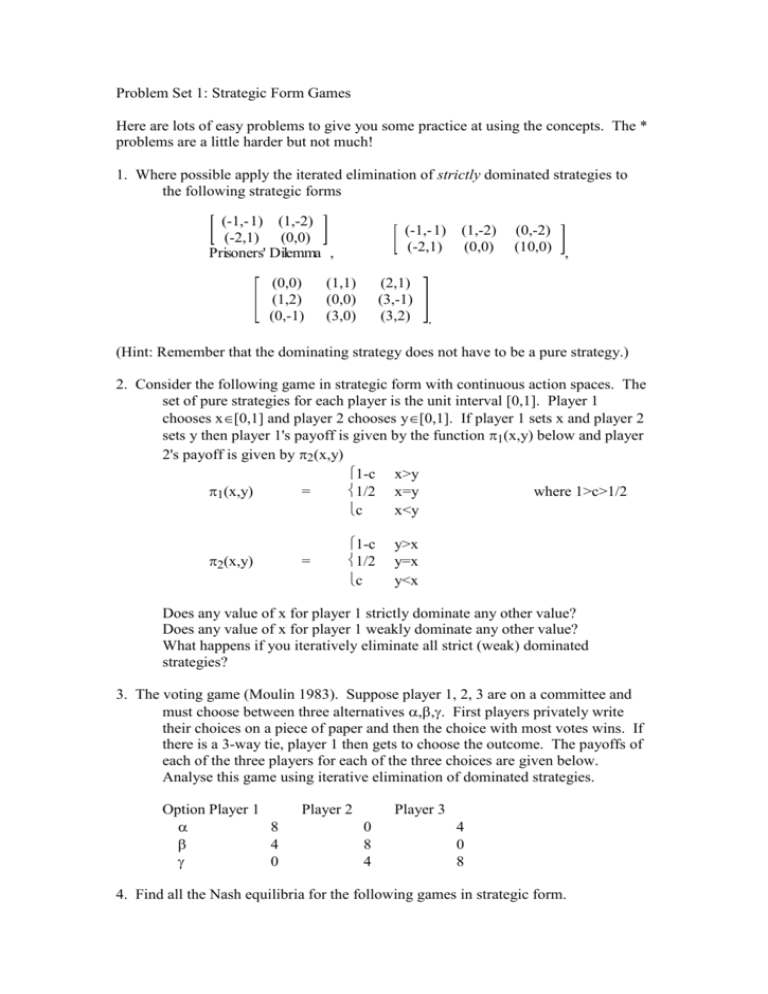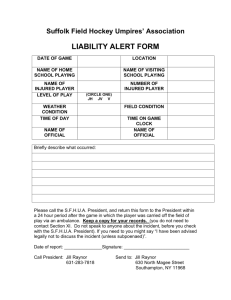Problem Set 1: Strategic Form Games
advertisement

Problem Set 1: Strategic Form Games Here are lots of easy problems to give you some practice at using the concepts. The * problems are a little harder but not much! 1. Where possible apply the iterated elimination of strictly dominated strategies to the following strategic forms (-1,-1) (1,-2) (-2,1) (0,0) Prisoners' Dilemma , (0,0) (1,2) (0,-1) (-1,-1) (-2,1) (1,1) (0,0) (3,0) (1,-2) (0,0) (0,-2) (10,0) , (2,1) (3,-1) (3,2) . (Hint: Remember that the dominating strategy does not have to be a pure strategy.) 2. Consider the following game in strategic form with continuous action spaces. The set of pure strategies for each player is the unit interval [0,1]. Player 1 chooses x[0,1] and player 2 chooses y[0,1]. If player 1 sets x and player 2 sets y then player 1's payoff is given by the function 1(x,y) below and player 2's payoff is given by 2(x,y) 1-c x>y 1(x,y) = 1/2 x=y where 1>c>1/2 c x<y 2(x,y) = 1-c 1/2 c y>x y=x y<x Does any value of x for player 1 strictly dominate any other value? Does any value of x for player 1 weakly dominate any other value? What happens if you iteratively eliminate all strict (weak) dominated strategies? 3. The voting game (Moulin 1983). Suppose player 1, 2, 3 are on a committee and must choose between three alternatives ,,. First players privately write their choices on a piece of paper and then the choice with most votes wins. If there is a 3-way tie, player 1 then gets to choose the outcome. The payoffs of each of the three players for each of the three choices are given below. Analyse this game using iterative elimination of dominated strategies. Option Player 1 8 4 0 Player 2 Player 3 0 8 4 4 0 8 4. Find all the Nash equilibria for the following games in strategic form. (a) (c) (0,0) (1,-3) (-3,1) (-1,-1) (3,1) (0,0) (0,0) (1,3) (e) (2,10) (0,0) (g) (1,1) (0,0) (0,0) (0,0) (1,1) (0,0) (0,0) (0,0) (1,1) (i) (0,0) (1,-1) (-1,1) (1,0) (0,10) (-1,1) (0,0) (1,-1) (1,3) (5,3) (b) (1,-1) (-1,1) (-1,1) (1,-1) (d) (10,0) (10,1) (5,2) (2,0) (f) (4,3) (5,5) (2,7) (5,-1) (1,1) (0,0) (0,3) (0,0) (1,1) (0,0) (3,0) (0,0) (1,1) (h) (1,-1) (-1,1) (0,0) (j) (0,4) (-4,-2) (2,0) (3,2) (2,2) (2,-1) (3,2) (1,1) (1,6) (2,8) (4,2) (3,1) (3,7) (4,6) (5,3) (4,2) (4,10) (2,1) 5. As the parameter ‘a’ varies explain how the set of Nash equilibria for the game below alters. (3,2) (a,a) (0,0) (2,3) 6. Consider the following Bayesian game. Player 1 is a buyer with a value for the good v that is distributed U(0,1). And Player 2 is a seller with a use value of the good c that is distributed U(0,1). They each have 2 actions trade or no trade. When trade occurs it is arranged by an intermediary at the average of the two values. Hence, they play the following game. Seller Trade Trade ( v-½(v+c), ½(v+c)-c) No trade (0,0) No Trade (0,0) (0,0) Buyer Assume they follow cut-off strategies so that low value buyers do not trade and high cost sellers do not trade. Find a Bayes-Nash equilibrium.









